When we started WPBeginner back in 2009, we chose WordPress because it gave us complete control over our content. But lately, many of our readers have been asking about Substack, especially since it’s become such a popular platform for writers and creators.
After spending countless hours testing both platforms and analyzing the pros and cons, we’ve gained a clear understanding of what each platform does best.
Today, we’re sharing everything we learned to help you make the right choice for your content business. No technical jargon, just practical insights based on real testing and experience with both platforms. So, is Substack or WordPress the right choice for you? Let’s find out!
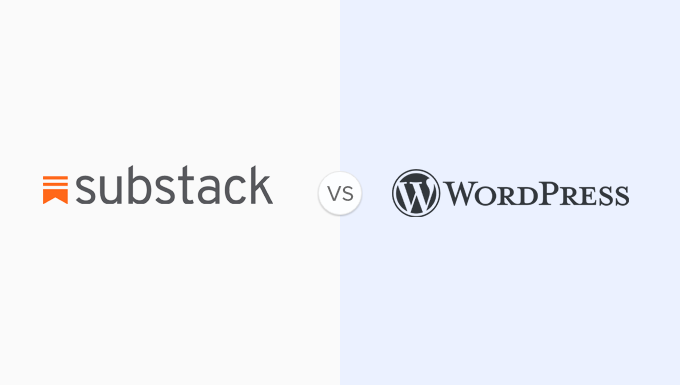
Editor’s Note: Looking for a more affordable Substack alternative? We recommend Kit (formerly ConvertKit). It has all the powerful features without the predatory pricing of Substack, which takes 10% of your newsletter revenue.
Since this is a detailed comparison of Substack vs. WordPress, here’s a quick table of contents:
Overview: Substack vs. WordPress
Before we start with our in-depth comparison, let’s cover the fundamentals and point out what makes each platform unique.
What Is Substack?
Substack is an online platform specifically designed for publishing newsletters. It makes it easy for you to send newsletter emails to your audience.
You can have both paid and free subscriptions, and Substack takes a percentage of any revenue you earn from your paid subscribers. In addition to newsletters, you also get a basic website and podcast hosting.
With paid subscriptions, you can think of Substack as a Patreon alternative for newsletters.
However, Substack doesn’t have all the functionality of a typical blogging platform or a content management system.
What Is WordPress?
WordPress is the world’s most popular website builder. It allows you to easily make any website you want. It also works seamlessly with almost all of the well-known email marketing services, so you can easily send out newsletters to your audience.
You can offer both free and paid newsletter subscriptions through WordPress. Additionally, you can use WordPress to build a podcasting website, an online store, a membership website, or pretty much any other kind of site you want.
Note: When we say WordPress, we are talking about self-hosted WordPress.org and not WordPress.com. For a clearer understanding of the difference, please see our guide on WordPress.org vs. WordPress.com.
What to Look For in a Subscription Platform
Picking the right platform for your subscription content is a really big deal. Once you start building an audience, moving to a different platform can be tough, and you might even lose some of your readers along the way.
Here are a few key things you should think about when choosing your subscription platform:
- Ease of Use – How simple is it to get up and running on your own?
- Costs – What will it actually cost you?
- Integrations – Can you connect the platform with other tools to help your audience grow?
- Data Portability – Can you easily take your content and subscriber information elsewhere if you need to?
With these important points in mind, let’s take a closer look at Substack versus WordPress.
Ease of Use
Most publishers are not professional website designers or marketers. Choosing an easy-to-use platform helps them focus on their strengths and leave the technical details aside.
Substack: Ease of Use
We found Substack to be incredibly easy for bloggers to use. Even if you’re completely new to online publishing, you can feel comfortable using it quickly. All you need to do is sign up, and you can start working on your content right away.

Substack is highly focused on writers and easy publishing (similar to Medium).
It comes with a minimalist editor where you can create newsletter emails, write great articles, and upload podcast episodes.
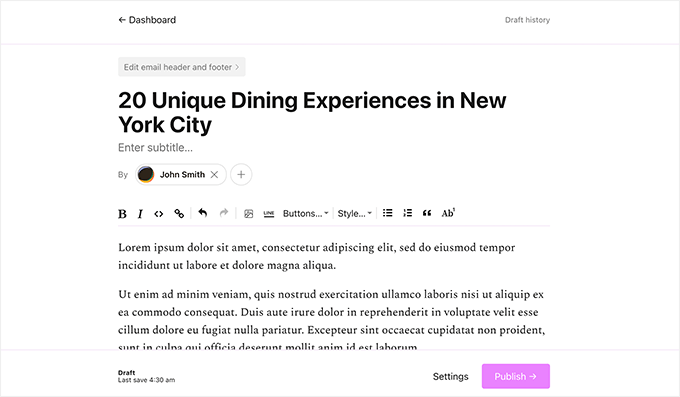
You can easily choose whether to send a specific article to your paid subscribers only, or to everyone on your list.
While writing a post is super easy, the default Substack editor doesn’t offer a lot of creative freedom. There are fewer options for customization and formatting.
WordPress: Ease of Use
WordPress is open-source software, which means you install it yourself and manage updates and backups. While this may sound technical, WordPress is incredibly easy to install and use.
You just need a domain name (your website’s address) and a web hosting account to get WordPress up and running.
We recommend using Bluehost, as they’re one of the biggest hosting companies in the world and an officially recommended WordPress hosting provider.
Even better, they’re offering WPBeginner readers a free domain name and a generous discount on hosting. This means you can get started for $1.99 per month.
Bluehost will automatically install WordPress for you, so you can simply log in to your WordPress dashboard to get started. Easy peasy!
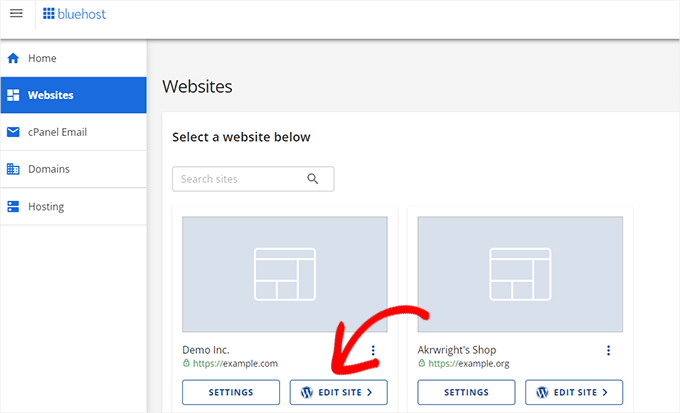
WordPress comes with an intuitive and powerful block editor, which is a pleasure to use.
This allows you to create content on your website and design it any way you like.
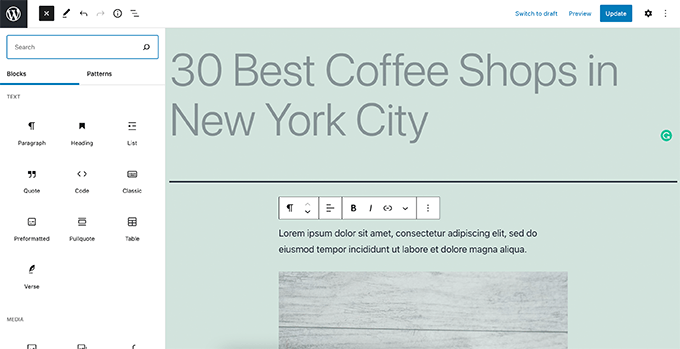
To put your premium content behind a paywall, you’ll need a plugin such as MemberPress. In our opinion, MemberPress is the best WordPress membership plugin since you can easily restrict content based on a user’s subscription plan.
In fact, we use MemberPress on our own WPBeginner online courses site.
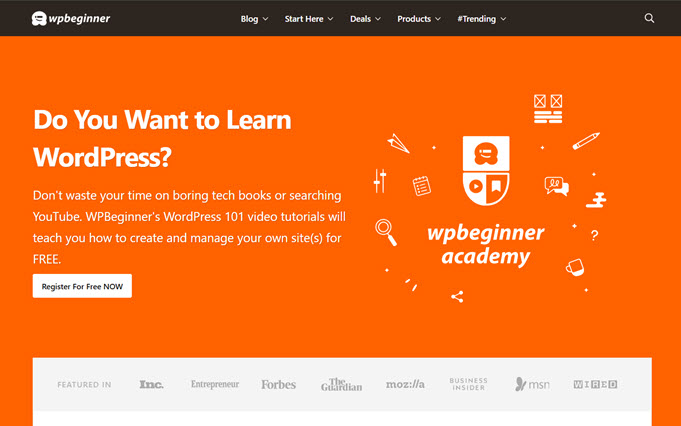
Want to know more about how we use MemberPress and what it can do? Then definitely take a look at our in-depth MemberPress review.
Unlike Substack, where you can have only one subscription plan for all users, MemberPress lets you create multiple subscription levels with different benefits.
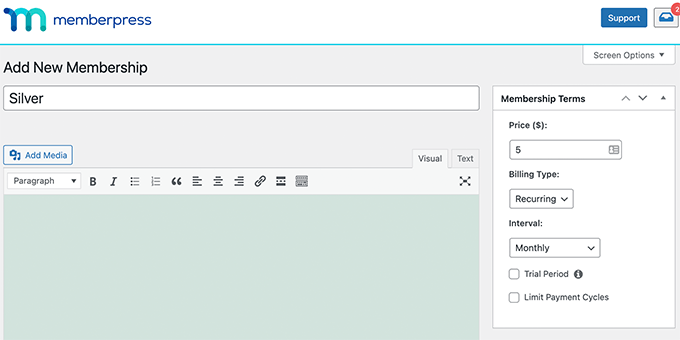
To send newsletters, you’ll need to connect WordPress to an email marketing service. We recommend Constant Contact, as it’s a great email platform for small businesses (check out our Constant Contact review for more information).
However, with WordPress, you have the freedom to choose from many different email newsletter platforms like Brevo (formerly Sendinblue), Drip, Kit, Mailchimp, and more.
For step-by-step instructions, see our article on how to create a paid newsletter in WordPress.
Winner: Substack
Cost of Running a Paid Subscription Service
The next important factor to consider is the cost of running a paid subscription service. If the costs are too high and you’re not making much profit, you may struggle to grow your business.
In our experience, many great online ideas don’t succeed because they can’t make money, and that slowly makes it hard to keep going.
Actual Cost of Substack Paid Newsletter
You can send free newsletters to your free subscribers, which is great for building your audience. However, this won’t bring in much profit in the long run.
To make money, you can add a paid subscription option for your newsletter. This lets you send exclusive content only to your paying subscribers.
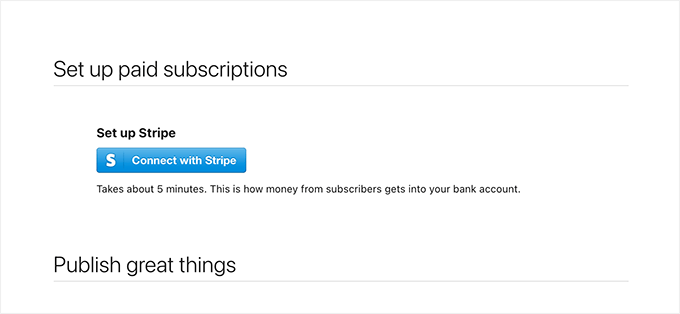
Substack uses Stripe for handling payments, which is available in certain countries. If your country doesn’t support Stripe, then you won’t be able to receive payments.
Both Substack and Stripe take a cut from each transaction. Substack charges 10%, and Stripe charges 2.9% + 30 cents.
If you charge $10 per subscriber, then the Substack + Stripe fee will be $1.59.
This may not sound like much, but let’s suppose you have 100 paid subscribers, each paying $10 per month. You would end up paying $159 in fees each month, and $1908 in fees every year!
Cost of a Paid Newsletter Using WordPress
WordPress lets you choose your own email platform, website hosting, plugins, and other tools. This gives you control over how much you spend, and you can decide the costs for your paid newsletter subscription.
You can get website hosting with a free domain name via Bluehost for just $1.99 per month.
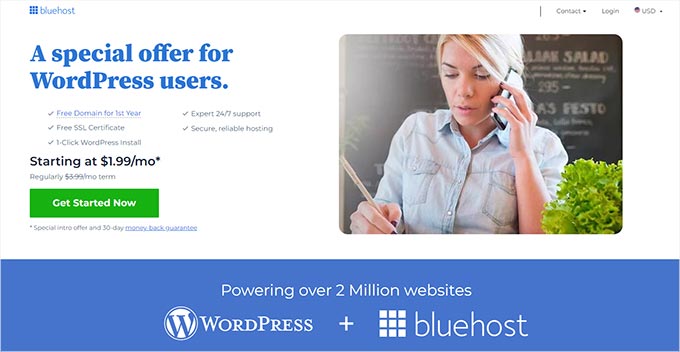
The cost of email platforms varies. For instance, Constant Contact plans start at $20 per month and vary based on the number of contacts.
Similarly, you can start for free with Brevo (Sendinblue), which allows you to send up to 300 emails daily. After that, you can upgrade to their lite plan, which allows you to send up to 10,000 emails per day for $25.
Besides email marketing, you’ll need a plugin like MemberPress to handle your paid subscriptions. Their basic plan starts at around $180 per year.
You can use payment gateways like Stripe, PayPal, and Authorize.net with WordPress. These payment gateways will have their own transaction fees, which is something else you’ll need to consider.
In the long run, WordPress gives you more freedom to cut down costs and increase your profits because you can shop around for the best deals on hosting, email services, and payment gateways.
For more details, see the costs involved in making a subscription/membership website.
Winner: WordPress
Integrations Available to Grow Subscribers
You cannot just publish content and wait for readers and revenue to come in magically. You need to actively reach out to your target audience to build momentum and grow your subscriber base.
In order to promote your paid newsletter, you’ll want to use third-party tools. Let’s see how Substack and WordPress compare in terms of available integrations.
Substack Integrations
Substack is designed as an all-in-one platform, which means it has very limited options for integrating with other external services.
It comes with limited SEO features built into the platform. You can connect your custom domain name, Google Analytics tracking ID, and social media profiles from the settings page.
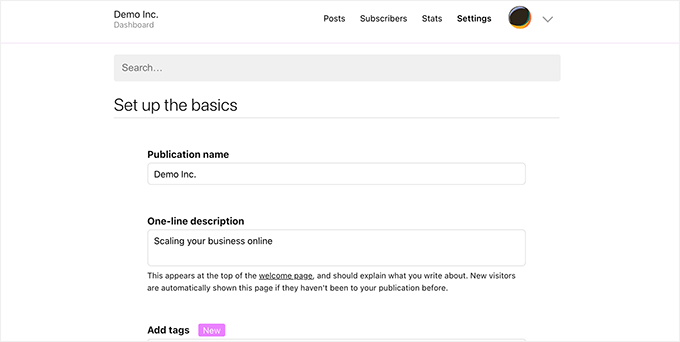
To attract more your subscribers, you will need to promote your Substack on social media platforms. This can make it challenging for writers who don’t have a large following just yet.
The platform does not allow you to customize your designs, use custom fonts, or use formatting and design options to engage users.
These limited integrations also restrict your ability to access other tools that could potentially help you convert more casual visitors into paying subscribers.
We found Substack quite limited in terms of growth tools. It seems best suited for publishers who already have a significant audience on social media.
WordPress Integrations
WordPress is an open-source platform with thousands of third-party integrations available. These allow you to easily increase the number of subscribers to your paid newsletter.
With more than 59,000 free plugins and thousands more paid integrations, WordPress gives you the freedom to use virtually any tool you need to grow your business effectively.
Here are some of the popular integrations and add-ons that will help you grow your paid newsletter:
- All in One SEO for WordPress – A complete SEO solution for WordPress websites that helps you improve your site’s search engine rankings and attract more free traffic from search engines
- OptinMonster – The best conversion optimization software on the market that helps you convert website visitors into paying subscribers.
- WPForms – The leading form builder plugin, allowing you to easily create newsletter signup forms and contact forms, with built-in integrations for various payment gateways and email marketing services.
- MonsterInsights – An easy-to-use Google Analytics plugin for WordPress. It shows where your visitors are coming from and tracks how users interact with your content.
- SeedProd – Need a quick landing page for a new campaign? SeedProd lets you easily design landing pages for your website. It comes with beautiful templates and an intuitive drag-and-drop design tool.
Want even more ideas for essential tools? Take a look at our selection of must-have WordPress plugins for any new online business.
Winner: WordPress
Data Portability
Both WordPress and Substack allow you to download your data and use it elsewhere. This is important in case you ever want to switch services.
Substack Data Portability
Substack makes it easy to download all your posts, pages, and email list subscribers. To do so, go to the Settings page and scroll down to the ‘Export your data’ section.
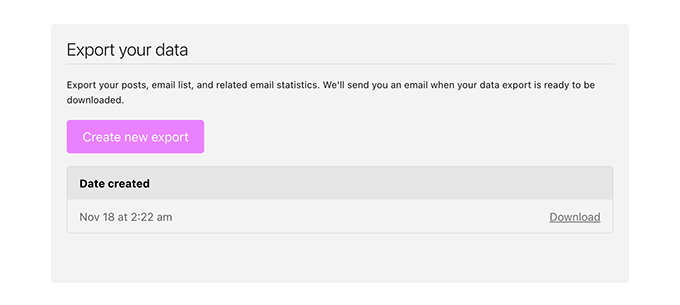
From here, you can download all your Substack data to your computer.
Your newsletter email subscribers list is in CSV format, which allows you to easily import subscribers into other email services. However, it’s worth noting that most email services will require your subscribers to confirm their subscription again, and some users might not choose to re-subscribe.
For the post data, you can use the Substack importer to import the data into a WordPress blog or website.
WordPress Data Portability
WordPress allows you to export all your data using the built-in export tools. This includes all your posts, pages, comments, users, and other website content.
Simply go to the Tools » Export page to download your export file.

Your newsletter subscriber data is safely stored with your third-party email service provider. The good news is that almost all reputable email marketing companies make it easy for you to export your email list, which you can then use with another service if needed.
Once again, if you import your email list into a new email service, they may require users to opt in again.
Winner Tie
Conclusion: WordPress vs. Substack: Which One Is Better?
When we look at the overall picture, WordPress comes out ahead of Substack in terms of flexibility, how easily it can grow with your needs, and how much money you can potentially make.
WordPress gives you more options for growing your newsletter and provides access to a much wider range of tools and plugins to help you do just that.
Plus, you are not just limited to paid subscriptions for monetization. You can expand your website to sell digital downloads, display advertisements, create paid forums, and explore many other ways to generate income.
On the other hand, Substack might be a better fit if your primary focus is simply sending out free newsletters and hosting a basic blog without needing lots of extra features.
However, keep in mind that you won’t have the same level of flexibility as you do with WordPress. Plus, if you decide to introduce paid subscriptions, then Substack takes a significant percentage of your earnings.
If you don’t want to use WordPress but still want a more affordable Substack alternative, we recommend Kit. It has all the powerful features without Substack’s high fees.
We hope this article helped you compare Substack and WordPress. You may also want to see our tutorial on creating an author website in WordPress or take a look at some examples of the different types of websites you can create with WordPress.
If you liked this article, then please subscribe to our YouTube Channel for WordPress video tutorials. You can also find us on Twitter and Facebook.





Teresa Blaes
I am considering substack as i am blind, but want to start a news letter. I have many wp sites for our podcast production company and other things, but I want to develope a following and maybe in future offer a paid subscription thanks for the read, gives me something to think about.
WPBeginner Support
Glad our guide could give you more to think about
Admin
Ridho
I have a WordPress website where I publish long format blog-posts (for free). Profiting from my writing is yet to be a concern of mine, but it may be in future as I get better and it becomes more professionally informative (I write predominately about architecture, but am not limited to it). Your post has me leaning towards retaining my WordPress site, rather than shifting to Substack, which I was pondering, as the design of the webpage is of great concern to me and my writing often includes pictures that I prefer to be properly composed alongside the text.
My main wonder is whether Substack allows greater opportunity for audience growth, given that it appears (I’ve really not researched it enough) as a major platform with a large number of subscribers, and I would assume there’s the possibility of drawing from this pool organically via Substack itself. From this article I get the impression that with either WordPress or Substack, audiences would still mainly be drawn from social media i.e. Instagram, Facebook etc… and that there is no advantage for either in this regard. Please let me know if it’s otherwise.
WPBeginner Support
There is a possibility that your site could rank if Substack decided to feature you in their discoverability but you cannot guarantee your site will be featured. We would normally recommend WordPress first as it would give more tools and options to be discovered by search engines as well as when you share on social media.
Admin
Bob
I’ve used both. I love how easy it is to post to Substack. WordPress I feel like I have to wear many hats. While that’s fun and I see the scalability, it’s a continual learning curve. I find SEO a grind. But I agree ultimately WordPress is more powerful. I love your blog. It’s such a great resource! Bob
WPBeginner Support
Thanks for sharing your opinion and glad you like our site!
Admin